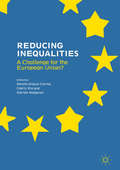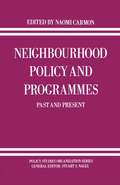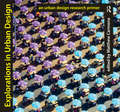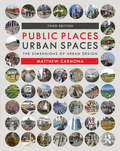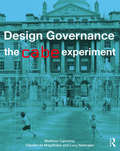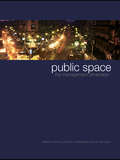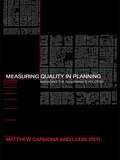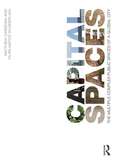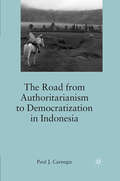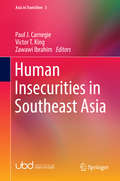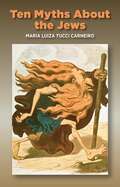- Table View
- List View
Reducing Inequalities: A Challenge for the European Union?
by Renato Miguel Carmo Cédric Rio Márton MedgyesiThis edited collection analyses social inequality in the European Union, within and between countries. The work critically explores both vertical inequality, existing between those with high incomes and low incomes, and horizontal inequality, existing between groups according to nationality, age, ethnicity, and gender. Reducing Inequalities has been written by leading academics in the field who describe the current social situation in the European Union, focussing on inequality from a multidimensional perspective that includes income, poverty, social exclusion, education. The authors argue that social issues such as these have become national prerogatives for countries within the European Union. In response they ask: How does the European Union engage with inequality today? What principles of social solidarity ought to be applied between states and citizens of the European Union? What should be the role of European Union and its institutions regarding the challenge of reducing inequality? This book will be of interest to anyone seeking to understand inequality as a multidimensional concept, rather than solely as an economic phenomenon, across different geographical and historical contexts.
Reducing Inequalities: A Challenge for the European Union?
by Renato Miguel Carmo Cédric Rio Márton MedgyesiThis edited collection analyses social inequality in the European Union, within and between countries. The work critically explores both vertical inequality, existing between those with high incomes and low incomes, and horizontal inequality, existing between groups according to nationality, age, ethnicity, and gender. Reducing Inequalities has been written by leading academics in the field who describe the current social situation in the European Union, focussing on inequality from a multidimensional perspective that includes income, poverty, social exclusion, education. The authors argue that social issues such as these have become national prerogatives for countries within the European Union. In response they ask: How does the European Union engage with inequality today? What principles of social solidarity ought to be applied between states and citizens of the European Union? What should be the role of European Union and its institutions regarding the challenge of reducing inequality? This book will be of interest to anyone seeking to understand inequality as a multidimensional concept, rather than solely as an economic phenomenon, across different geographical and historical contexts.
In the Path of the Masters: Understanding the Spirituality of Buddha, Confucius, Jesus, and Muhammad
by Denise Lardner Carmody John Tully CarmodyReflecting on the legacy of four great religious figures, this book places each in their historical context, offers glimpses of what they were like personally, assesses how they saved their followers from confusion, and traces each religious tradition after its founder's death.
In the Path of the Masters: Understanding the Spirituality of Buddha, Confucius, Jesus, and Muhammad
by Denise Lardner Carmody John Tully CarmodyReflecting on the legacy of four great religious figures, this book places each in their historical context, offers glimpses of what they were like personally, assesses how they saved their followers from confusion, and traces each religious tradition after its founder's death.
Neoliberalism, Civil Society and Security in Africa (International Political Economy Series)
by P. CarmodyFree market policies have been in operation across Africa for the past 25 years, yet they have failed to reverse deepening poverty. This book explores, with case studies, why such policies continue to be implemented and the ways in which they have been reinvented by socialization, depoliticization, regionalization and securitization.
The Rise of the BRICS in Africa: The Geopolitics of South-South Relations
by Pádraig CarmodyA little over a decade ago Africa was being spoken of in the media as the 'lost' or 'hopeless' continent. Now it has some of the fastest growing economies in the world, largely because of the impact of the BRICS: Brazil, Russia, India, China and South Africa. In this first book to be written about the BRICS as a collective phenomenon, Pádraig Carmody reveals how their engagements with Africa, both individually and collectively, are often contradictory, generating new inequalities and potential for development. Crucially, Carmody shows how the geopolitics of the BRICS countries' involvement in Africa is impacted by and impacts upon their international relations more generally, and how the emergence of these economies has begun to alter the very nature of globalization, which is no longer purely a Western-led project.This is a path-breaking examination of Africa's changing role in the world.
The Rise of the BRICS in Africa: The Geopolitics of South-South Relations
by Pádraig CarmodyA little over a decade ago Africa was being spoken of in the media as the 'lost' or 'hopeless' continent. Now it has some of the fastest growing economies in the world, largely because of the impact of the BRICS: Brazil, Russia, India, China and South Africa. In this first book to be written about the BRICS as a collective phenomenon, Pádraig Carmody reveals how their engagements with Africa, both individually and collectively, are often contradictory, generating new inequalities and potential for development. Crucially, Carmody shows how the geopolitics of the BRICS countries' involvement in Africa is impacted by and impacts upon their international relations more generally, and how the emergence of these economies has begun to alter the very nature of globalization, which is no longer purely a Western-led project.This is a path-breaking examination of Africa's changing role in the world.
Africa's Shadow Rise: China and the Mirage of African Economic Development (Politics and Development in Contemporary Africa)
by Pádraig Carmody Peter Kragelund Ricardo ReboredoFor years economists have spoken of 'Africa rising', and despite the global financial crisis, Africa continues to host some of the fastest growing economies in the world.Africa's Shadow Rise however argues that the continent's apparent economic 'rise' is essentially a mirage, driven by developments elsewhere - most particularly the expansion in China's economy. While many African countries have experienced high rates of growth, much of this growth may prove to be unsustainable, and has contributed to environmental destruction and worsening inequality across the continent. Similarly, new economic relationships have produced new forms of dependency, as African nations increasingly find themselves tied to the fortunes of China and other emerging powers.Drawing on in-depth fieldwork in southern Africa, Africa's Shadow Rise reveals how the shifting balance of global power is transforming Africa's economy and politics, and what this means for the future of development efforts in the region.
Africa's Shadow Rise: China and the Mirage of African Economic Development (Politics and Development in Contemporary Africa)
by Pádraig Carmody Peter Kragelund Ricardo ReboredoFor years economists have spoken of 'Africa rising', and despite the global financial crisis, Africa continues to host some of the fastest growing economies in the world.Africa's Shadow Rise however argues that the continent's apparent economic 'rise' is essentially a mirage, driven by developments elsewhere - most particularly the expansion in China's economy. While many African countries have experienced high rates of growth, much of this growth may prove to be unsustainable, and has contributed to environmental destruction and worsening inequality across the continent. Similarly, new economic relationships have produced new forms of dependency, as African nations increasingly find themselves tied to the fortunes of China and other emerging powers.Drawing on in-depth fieldwork in southern Africa, Africa's Shadow Rise reveals how the shifting balance of global power is transforming Africa's economy and politics, and what this means for the future of development efforts in the region.
Neighbourhood Policy and Programmes: Past and Present (Policy Studies Organization Series)
by Naomi CarmonThis volume, comprised of original contributions by experienced urban planners and distinguished social scientists, sets forth the accumulated experience directed at improving the quality of life in our cities through neighbourhood programs. Policy issues, housing programs and job development plans, along with organizational innovations aimed at redistribution of power, are described and evaluated.
Explorations in Urban Design: An Urban Design Research Primer
by Matthew CarmonaWhilst recognising that distinctly different traditions exist within the study and practice of urban design, this book advances an interdisciplinary and innovative approach, which is of direct importance to understanding the urban forms, conditions, practices and processes. It enthuses and inspires users who are grappling with urban design research problems, but who need inspiration to move from idea to methodological approach. Through the work of 32 urban researchers from the arts, sciences and social sciences, it demonstrates a wide range of problems and approaches and shows how the diverse range of complementary approaches can come together to provide a holistic understanding to the design of cities. While each of the contributors presents a particular approach to researching the field, sometimes focusing centrally on particular research methodologies, others cutting across methods, or focusing on theory, all include discussion of actual research projects to illustrate their application to 'real world' problems. This book will be valuable to everyone from the informed undergraduate student about to embark on their first dissertation, to PhD students and seasoned researchers immersed in methodological and conceptual complexity and wishing to compare available and appropriate methodological paths.
Explorations in Urban Design: An Urban Design Research Primer
by Matthew CarmonaWhilst recognising that distinctly different traditions exist within the study and practice of urban design, this book advances an interdisciplinary and innovative approach, which is of direct importance to understanding the urban forms, conditions, practices and processes. It enthuses and inspires users who are grappling with urban design research problems, but who need inspiration to move from idea to methodological approach. Through the work of 32 urban researchers from the arts, sciences and social sciences, it demonstrates a wide range of problems and approaches and shows how the diverse range of complementary approaches can come together to provide a holistic understanding to the design of cities. While each of the contributors presents a particular approach to researching the field, sometimes focusing centrally on particular research methodologies, others cutting across methods, or focusing on theory, all include discussion of actual research projects to illustrate their application to 'real world' problems. This book will be valuable to everyone from the informed undergraduate student about to embark on their first dissertation, to PhD students and seasoned researchers immersed in methodological and conceptual complexity and wishing to compare available and appropriate methodological paths.
Public Places Urban Spaces: The Dimensions of Urban Design
by Matthew CarmonaPublic Places Urban Spaces provides a comprehensive overview of the principles, theory and practices of urban design for those new to the subject and for those requiring a clear and systematic guide. In this new edition the book has been extensively revised and restructured. Carmona advances the idea of urban design as a continuous process of shaping places, fashioned in turn by shifting global, local and power contexts. At the heart of the book are eight key dimensions of urban design theory and practice—temporal, perceptual, morphological, visual, social, functional—and two new process dimensions—design governance and place production. This extensively updated and revised third edition is more international in its scope and coverage, incorporating new thinking on technological impact, climate change adaptation, strategies for urban decline, cultural and social diversity, place value, healthy cities and more, all illustrated with nearly 1,000 carefully chosen images. Public Places Urban Spaces is a classic urban design text, and everyone in the field should own a copy.
Public Places Urban Spaces: The Dimensions of Urban Design
by Matthew CarmonaPublic Places Urban Spaces provides a comprehensive overview of the principles, theory and practices of urban design for those new to the subject and for those requiring a clear and systematic guide. In this new edition the book has been extensively revised and restructured. Carmona advances the idea of urban design as a continuous process of shaping places, fashioned in turn by shifting global, local and power contexts. At the heart of the book are eight key dimensions of urban design theory and practice—temporal, perceptual, morphological, visual, social, functional—and two new process dimensions—design governance and place production. This extensively updated and revised third edition is more international in its scope and coverage, incorporating new thinking on technological impact, climate change adaptation, strategies for urban decline, cultural and social diversity, place value, healthy cities and more, all illustrated with nearly 1,000 carefully chosen images. Public Places Urban Spaces is a classic urban design text, and everyone in the field should own a copy.
Design Governance: The CABE Experiment
by Matthew Carmona Claudio De Magalhaes Lucy NatarajanDesign Governance focuses on how we design the built environment where most of us live, work, and play and the role of government in that process. To do so, it draws on the experience of the Commission for Architecture and the Built Environment (CABE), a decade-long, globally unique experiment in the governance of design. This book theorises design governance as an arm and aspiration of the state; tells the story of CABE, warts and all, and what came before and after; unpacks CABE’s ‘informal’ toolbox: its methods and processes of design governance; and reflects on the effectiveness and legitimacy of design as a tool of modern-day government. The result is a new set of concepts through which to understand the governance of design as a distinct and important sub-field of urban design.
Design Governance: The CABE Experiment
by Matthew Carmona Claudio De Magalhaes Lucy NatarajanDesign Governance focuses on how we design the built environment where most of us live, work, and play and the role of government in that process. To do so, it draws on the experience of the Commission for Architecture and the Built Environment (CABE), a decade-long, globally unique experiment in the governance of design. This book theorises design governance as an arm and aspiration of the state; tells the story of CABE, warts and all, and what came before and after; unpacks CABE’s ‘informal’ toolbox: its methods and processes of design governance; and reflects on the effectiveness and legitimacy of design as a tool of modern-day government. The result is a new set of concepts through which to understand the governance of design as a distinct and important sub-field of urban design.
Public Space: The Management Dimension
by Matthew Carmona Claudio De Magalhães Leo HammondIn both the UK and the US there is a sense of dissatisfaction and pessimism about the state of urban environments, particularly with the quality of everyday public spaces. Explanations for this have emphasized the poor quality of design that characterizes many new public spaces; spaces that are dominated by parking, roads infrastructure, introspective buildings, a lack of enclosure and a poor sense of place, and which in different ways for different groups are too often exclusionary. Yet many well designed public spaces have also experienced decline and neglect, as the services and activities upon which the continuing quality of those spaces have been subject to the same constraints and pressures for change as public services in general. These issues touch upon the daily management of public space, that is, the coordination of the many different activities that constantly define and redefine the characteristics and quality of public space. This book draws on three empirical projects to examine the questions of public space management on an international stage. They are set within a context of theoretical debates about public space, its history, contemporary patterns of use and changing nature in western society, and about the new management approaches that are increasingly being adopted.
Public Space: The Management Dimension
by Matthew Carmona Claudio De Magalhães Leo HammondIn both the UK and the US there is a sense of dissatisfaction and pessimism about the state of urban environments, particularly with the quality of everyday public spaces. Explanations for this have emphasized the poor quality of design that characterizes many new public spaces; spaces that are dominated by parking, roads infrastructure, introspective buildings, a lack of enclosure and a poor sense of place, and which in different ways for different groups are too often exclusionary. Yet many well designed public spaces have also experienced decline and neglect, as the services and activities upon which the continuing quality of those spaces have been subject to the same constraints and pressures for change as public services in general. These issues touch upon the daily management of public space, that is, the coordination of the many different activities that constantly define and redefine the characteristics and quality of public space. This book draws on three empirical projects to examine the questions of public space management on an international stage. They are set within a context of theoretical debates about public space, its history, contemporary patterns of use and changing nature in western society, and about the new management approaches that are increasingly being adopted.
Measuring Quality in Planning: Managing the Performance Process
by Matthew Carmona Louie SiehThis book deals with one of the current major debates in planning: how to measure the quality and effectiveness of the output of the planning process. It deals with issues of defining quality, public sector management, the use of indicators and the planning process. Although case study material is drawn from UK practice this topic is universal and the authors include discussions of international practice and experience.
Measuring Quality in Planning: Managing the Performance Process
by Matthew Carmona Louie SiehThis book deals with one of the current major debates in planning: how to measure the quality and effectiveness of the output of the planning process. It deals with issues of defining quality, public sector management, the use of indicators and the planning process. Although case study material is drawn from UK practice this topic is universal and the authors include discussions of international practice and experience.
Capital Spaces: The Multiple Complex Public Spaces of a Global City
by Matthew Carmona Filipa Matos WunderlichIn recent years it has become common-place to hear claims that public space in cities across the globe has become the exclusive preserve of the wealthy and privileged, at the expense of the needs of wider society. Whether it is the privatization of public space through commerical developments like shopping malls and business parks, the gentrification of existing spaces by campaigns against perceived anti-social behaviour or the increasing domination of public areas by private transport in the form of the car, the urban public space is seen as under threat. But are things really that bad? Has the market really become the sole factor that influences the treatment of public space? Have the financial and personal interests of the few really come to dominate those of the many? To answer these questions Matthew Carmona and Filipa Wunderlich have carried out a detailed investigation of the modern public spaces of London, that most global of cities. They have developed a new typology of public spaces applicable to all cities, a typology that demonstrates that to properly assess contemporary urban places means challenging the over-simplification of current critiques. Global cities are made up of many overlapping public spaces, good and bad; this book shows how to analyze this complexity, and to understand it.
Capital Spaces: The Multiple Complex Public Spaces of a Global City
by Matthew Carmona Filipa Matos WunderlichIn recent years it has become common-place to hear claims that public space in cities across the globe has become the exclusive preserve of the wealthy and privileged, at the expense of the needs of wider society. Whether it is the privatization of public space through commerical developments like shopping malls and business parks, the gentrification of existing spaces by campaigns against perceived anti-social behaviour or the increasing domination of public areas by private transport in the form of the car, the urban public space is seen as under threat. But are things really that bad? Has the market really become the sole factor that influences the treatment of public space? Have the financial and personal interests of the few really come to dominate those of the many? To answer these questions Matthew Carmona and Filipa Wunderlich have carried out a detailed investigation of the modern public spaces of London, that most global of cities. They have developed a new typology of public spaces applicable to all cities, a typology that demonstrates that to properly assess contemporary urban places means challenging the over-simplification of current critiques. Global cities are made up of many overlapping public spaces, good and bad; this book shows how to analyze this complexity, and to understand it.
The Road from Authoritarianism to Democratization in Indonesia
by P. CarnegieThis book establishes that a tension exists between how we frame democratisation and the conclusions we arrive at. It demonstrates how and why interpreting ambiguity matters in the study of Indonesia's post-authoritarian settlement and highlights the need for dialogue with proponents of social conflict theory.
Human Insecurities in Southeast Asia (Asia in Transition #5)
by Paul J. Carnegie Victor T. King Zawawi IbrahimThis book is a collection of work by scholars currently pursuing research on human security and insecurities in Southeast Asia. It deals with a set of ‘insecurities’ that is not readily understood or measurable. As such, it conceptually locates the threats and impediments to ‘human security’ within relationships of risk, uncertainty, safety and trust. At the same time, it presents a wide variety of investigations and approaches from both localized and regional perspectives. By focusing on the human and relational dimensions of insecurities in Southeast Asia it highlights the ways in which vulnerable and precarious circumstances (human insecurities) are part of daily life for large numbers of people in Southeast Asia and are mainly beyond their immediate control. Many of the situations people experience in Southeast Asia represent the real outcomes of a range of largely unacknowledged socio-cultural-economic transformations interlinked by local, national, regional and global forces, factors and interests. Woven from experience and observations of life at various sites in Southeast Asia, the contributions in this volume give an internal and critical perspective to a complex and manifold issue. They draw attention to a variety of the less-than-obvious threats to human security and show how perplexing those threats can be. All of which underscores the significance of multidisciplinary approaches in rethinking and responding to the complex array of conditioning factors and interests underlying human insecurities in Southeast Asia.
Ten Myths About the Jews
by Maria CarneiroTen Myths about the Jews analyzes the complex facets of anti-Semitism and anti-Judaism in an accessible and easy-to-read format. Based on wide research, Brazilian historian Maria Luiza Tucci Carneiro examines different manifestations against Jews and their faith through history and political culture along the centuries. Ten omnipresent accusations were configured by anti-Semites in axioms that became myths: Myth 1: The Jews killed Christ. Myth 2: The Jews are a secret entity. Myth 3: The Jews control the world economy. Myth 4: There are no poor Jews. Myth 5: The Jews are greedy. Myth 6: The Jews have no homeland. Myth 7: The Jews are racists. Myth 8: The Jews are parasites. Myth 9: The Jews control the media. Myth 10: The Jews manipulate the United States. Tucci Carneiro unmasks the roots of anti-Semitism and exposes contemporary prejudices. Her book is an invitation to reflect upon current realities marked by racism and shows how the main myths about the Jews have been vested of a verisimilitude that has persisted for the last 2000 years, all over the world, by means of hatred of the other, political/religious opportunism and economic deceit. The myths are kept alive by means of constant repetition and re-elaboration of a particular narrative, invariably seductive. The author proves each of the ten myths in terms of their historical record, their origins and purposes. Even though Jews are fully integrated into western society in multiple ways (entrepreneurship, medicine, literature, philosophy, the arts), racist myths against the community have been particularly resilient; they attempt to override common sense and their continuous circulation and rehashing through scapegoating and caricature has had profound negative repercussions for society as a whole. Ten Myths, now published in five languages, is an essential tool in the struggle against the discourse of racist hatred.
